10 years and one month: speed up website hosting on AWS in four steps
There is no (milli)second chance for the first impression. Many websites today mess this up badly. When I need to wait 10 seconds for the content to load - I am out. What about you? I show you how to optimize the speed in four steps with S3, CloudFront and Amplify.

I will use these different technologies to speed up:

Step one: File Size
I am not going deep into that topic because there are thousands of articles about that. But the first step in speeding up your page content begins with the content itself. Resize the images to a reasonable size; you do not need 4k resolution on a website. Then choose the proper format for your pictures, and weigh size versus quality.
As an example, I show you a picture which could be a symbol for your not-optimized website straight out of the mobile cam 🤓:

The resolution of this picture is 4032 × 3024, which results in a size of 2.4 Mb—changing the resolution with the mac preview tool to 1008 × 756 results in 233 Kb, which loads much faster.
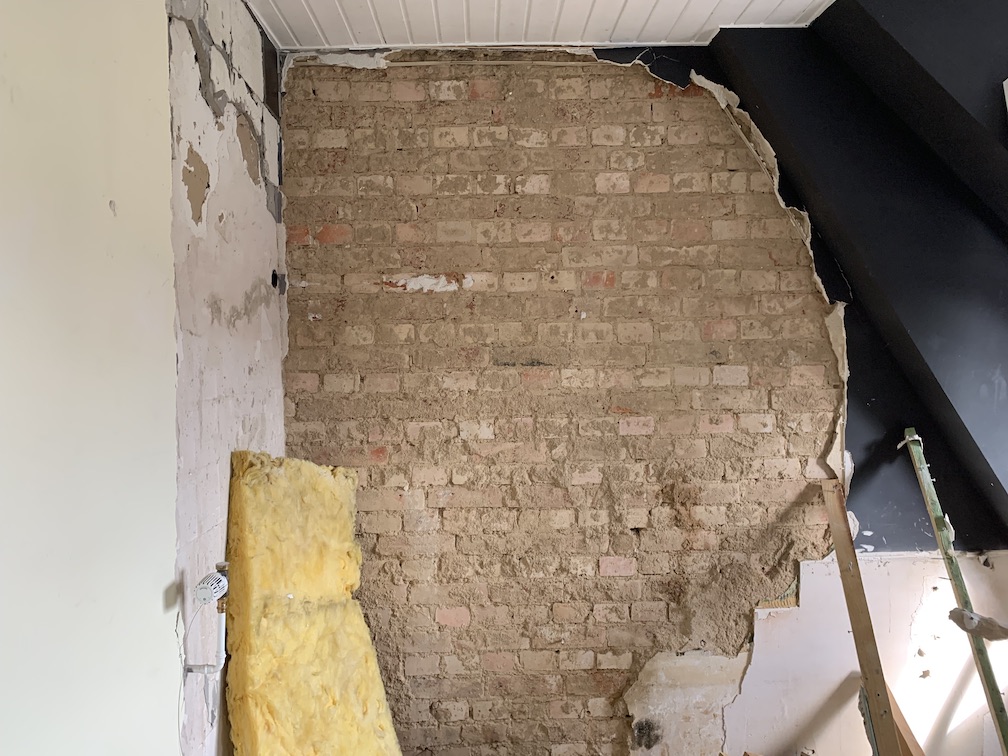
Doing the resize with ffmpeg, you even get down to 88k.
ffmpeg -i IMG_6202.jpeg -vf scale="1080:-1" IMG_6202-ffmpeg.jpg

ls -lkh IMG*
-rw-r--r-- 1 gglawe staff 88K 14 Okt 09:57 IMG_6202-ffmpeg.jpg
-rw-r--r--@ 1 gglawe staff 233K 14 Okt 09:50 IMG_6202-small.jpeg
-rw-r--r--@ 1 gglawe staff 2,3M 14 Okt 09:36 IMG_6202.jpeg
Decide for yourself about the quality loss of the picture - I can’t see any difference.
Step two: Static hosting
AWSblog.de is the blogging site of tecRacer. Co-founder Sven Ramuschkat started the blog ten years ago. See the First Blog Entry 2012. As a german company, we began in Deutsch and switched to English later. A few years later, I joined in. Now we have a steady team of bloggers.
 Celebrate 10 Years tecRacer AWS Blog
Celebrate 10 Years tecRacer AWS Blog
It started as a WordPress blog because that is very convenient for authors. But there is a downside. WordPress generates the pages on demand, so with each request, there is additional time to render the page on the server.
Migration from WordPress to S3
In the year 2015, our WordPress installation, running on an EC2 instance with a MySQL database, became unstable. Also, the content became more centred towards code. Therefore we decided to migrate the blog to goHugo and got some advantages:
1) Stable static pages on S3
Static pages on S3 are stable, S3 will not crash. Never happened.
2) Simpler Code integration
In hugo you can add code snippets like this shell command:
```bash
ffmpeg -i IMG_6202.jpeg -vf scale="1080:-1" IMG_6202-ffmpeg.jpg
```
Which hugo will render as:
ffmpeg -i IMG_6202.jpeg -vf scale="1080:-1" IMG_6202-ffmpeg.jpg
3) Page Speed
| System | Google Speed index |
|---|---|
| Wordpress |  |
| Hugo | 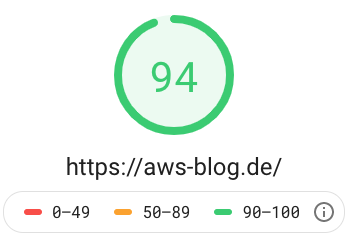 |
You see that the Google page speed index has much improved back then!
HUGO Deployment
For the following steps, I will use https://www.go-on-aws.com/ to measure caching effects.
Please refer to the HUGO documentation for details of creating a HUGO website. The deployment process has two commands:
- Generate static pages with the base url:
hugo --baseURL {{.baseurl}}
- Copy the generated files to S3:
aws s3 sync . s3://{{.bucket}}/ --delete --exclude ".git/*"
Step three: regional caching
With AWS Amplify Hosting you can really simplify website hosting. You don’t have to manage storage, DNS and CDN caching (3,4).
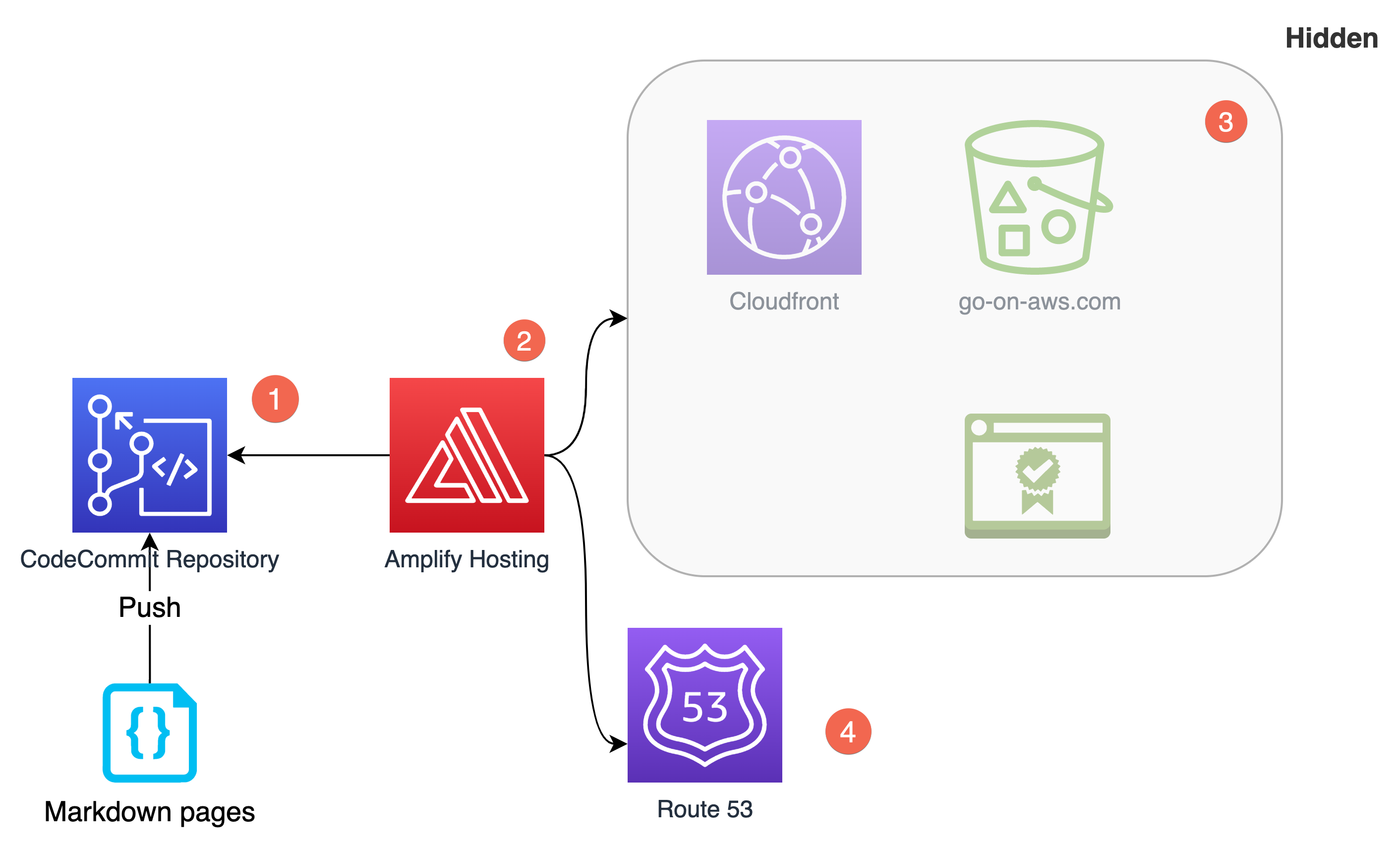
You connect Amplify Hosting to the branch of your repository (1). Amplify Hosting (2) generates a HUGO configuration for amplify.yml:
version: 1
frontend:
phases:
build:
commands:
- hugo
artifacts:
baseDirectory: public
files:
- '**/*'
cache:
paths: []
To add caching, https certificates and domain linking, you only add a R53 domain:

Amplify will add a hidden certificate and a hidden cloudfront (3). You will not see a CloudFront distribution in your account. But Amplify adds this entry to the R53 zone:
| Record | Type | Routing | Value |
|---|---|---|---|
| www.go-on-aws.com | CNAME | Simple | d3ervqc58400yu.cloudfront.net |
But why do I call this regional caching? Wait for the measurements to find out!
Deploy Amplify
You just push to your repository (1) and amplify will start the build in pipeline:

Step four: global caching
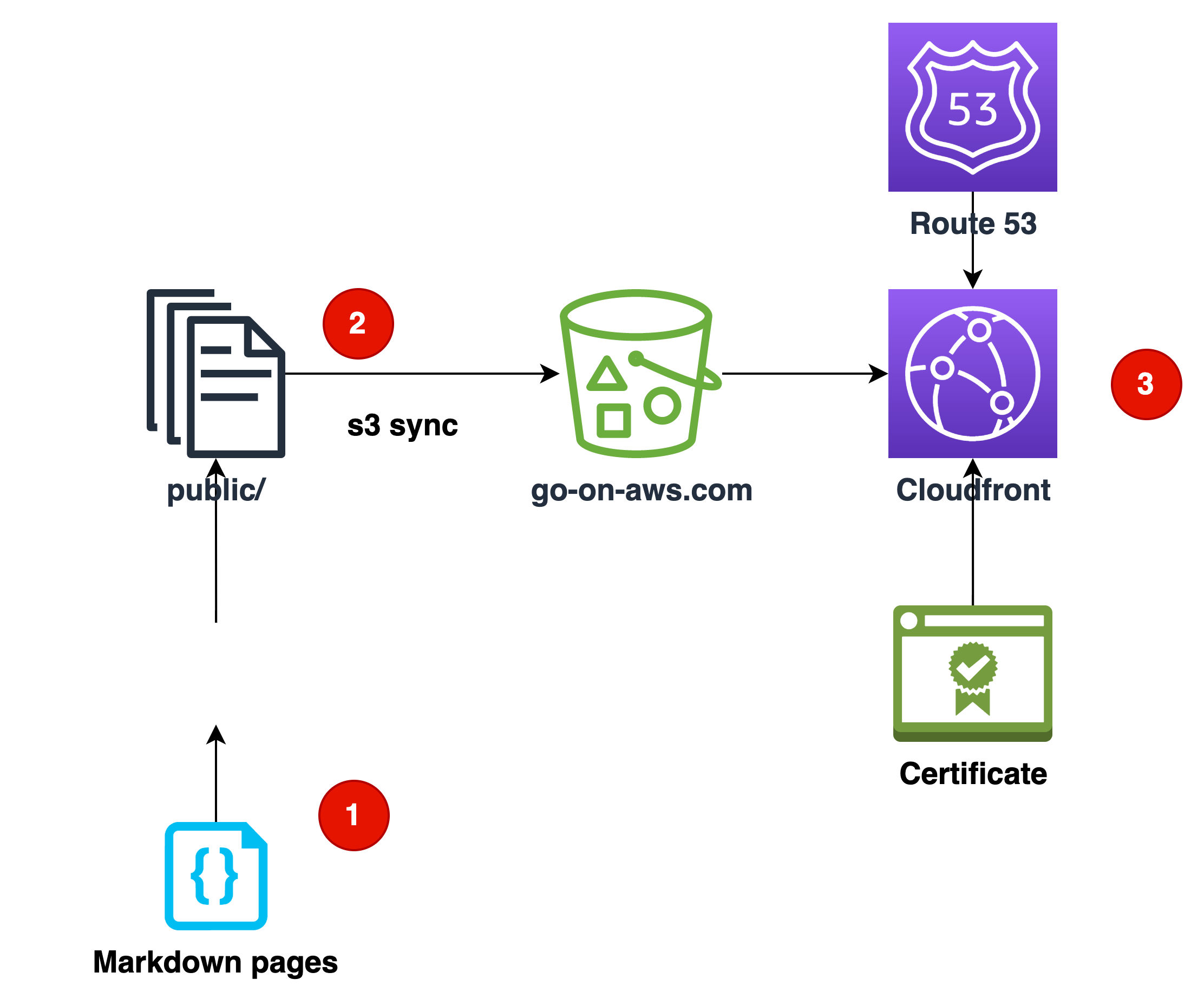
Now I create all AWS resources by myself. See the post Building a static website with Hugo and the CDK from Maurice for details how to do this with automatically with IaC.
This simplified architecture has 3 steps:
- Generate pages locally with HUGO:
hugo
- Synchronize local html pages and images with s3 bucket:
cd public && aws s3 sync . s3://build.go-on-aws.com --delete --exclude ".git/*" --profile go-on-aws
- CloudFront
Invalidate CloudFront Distribution:
aws cloudfront create-invalidation --distribution-id "{{.distid}}" --path "/*"
If you do not invalidate, old files will be valid until the TTL (time to live) expires. So changes especially in index.html are not displayed immediately.
Measure the results
Now I measure the page speeds of the different approaches. Because I want to test from different locations, I do not use Google pagespeed, but pingdom. With pingdom you can choose different geographic locations for the test.
I performed the measurement over a period of one month. In this way, statistical outliers are smoothed out on average.
Speed and architecture considerations
Location of the requester
Your customers access your site from several locations. So the measurement should be from several locations also.
Cloud-Provider of the requester
The sites are hosted on AWS. So when the requester site is also located on AWS, the traffic would only go through the AWS network. This type of measurement would give unrealistic values.
What is measured
Each measuring site has its own mix of values. So when you compare values, use one metric only. Comparing google page speed with pingdom won’t get you anywhere…
Request several times
The network load on the internet varies over time. So you have to measure several times to get reasonable values.
Do not take first value
We want to test the caches, which might be filled on the first request. Therefore, the first request might take longer than the average.
Stability
How often is the website down or how vulnerable to attacks is it?
Easy of operation
What do I have to to to get the data to the server.
Results
Data
| Type/Location | US | Asia | Europe |
|---|---|---|---|
| Amplify | 1.24 | 2.18 | 0.738 |
| S3 | 1.85 | 3.82 | 0.719 |
| S3+CloudFront | 0.591 | 0.568 | 0.537 |
The original results from pingdom:
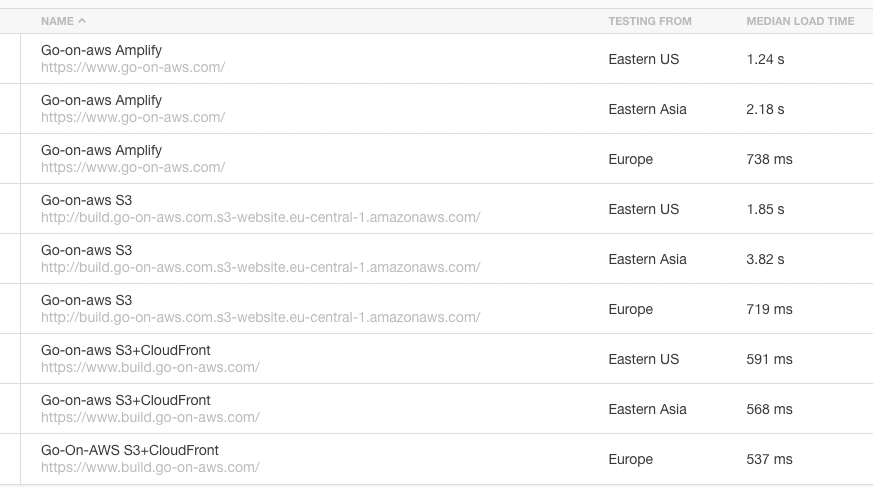
Here you see the different URLs which I used for the different architectures.
Overview
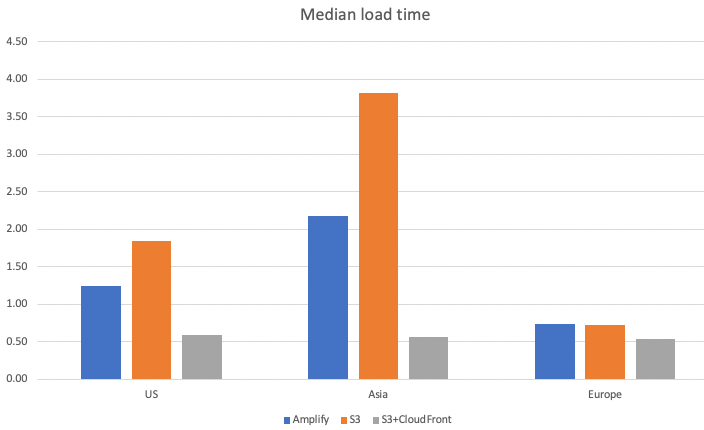
Smaller values are better, because of the faster load time.
Interpretation
CloudFront is the fastest
Because the S3 bucket is located in Europe in region eu-central-1, the load time is below 1 second. With CloudFront, you squeeze another 25% speed advantage out of the bucket.
So if you only have customers in Germany, CloudFront always gives you speed advantage compared to S3. If you look at the multiple locations of the Edge locations, you see that, e.g. for Germany locations are not only in Frankfurt, but also in Berlin, Hamburg, Düsseldorf, Munich. So this brings your data nearer to the customer.
Amplify Hosting behaviour
Amplify is faster than S3, but with the region eu-central-1 of the Amplify Hosting service the data implies that there is a regional cache reserved for amplify. In Europe CloudFront only is 0.019 seconds faster, which is negligible.
But outside the home region, in US CloudFront is about 100% faster than Amplify Hosting!
Conclusion
I have shown you how the different methods of Load-time optimization work. Amplify really is a managed service which helps you with management. So if you only have customers in Europe, Amplify is easy and OK from the load speed.
What surprised me is the significant difference between Amplify Hosting and CloudFront speed outside the home region. With the Amplify DNS entry, it becomes clear that Amplify does use CloudFront. But this seems to have only a small effect outside the home region.
So I would recommend going with S3/CloudFront whenever possible.
If you need consulting for your CloudFront project, don’t hesitate to get in touch with the sponsor of this blog, tecRacer.
For more AWS development stuff, follow me on twitter @megaproaktiv
See also
Thanks to
- Celebration image generated by DALL·E
